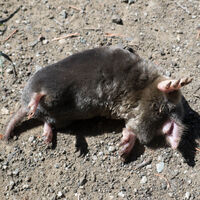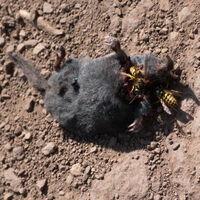moles, shrews, and voles
Member of
placental mammals (infraclass Placentalia)
mammals (class Mammalia)
animals (kingdom Animalia)
There are no other wild members of this group in the bay area.
broad-footed mole
Scapanus latimanus
Scapanus latimanus
- thick, velvety fur; dark brown to silvery
- ±6-inch body, 1-inch hairless [sparsely hairy] tail
- large front feet, facing outwards from the body
- elongated, hairless snout
- eyes and ears are hidden
- moles and shrews taste bad and are often discarded by predators
- ±4-inch body, 1-inch tail
- short, soft fur; grayish
- long, pointed snout
- eyes and ears are visible
- teeth are reddish-brown
- moles and shrews taste bad and are often discarded by predators
american shrewmole
Neurotrichus gibbsii
Neurotrichus gibbsii
- ±7-cm body, 3-inch tail that is thick and bristled
- dense, soft fur; dark gray to bluish-black
- front paws more like shrews
- long, flattened snout
- teeth are white
- eyes and ears are hidden
- [source]
california vole
Microtus californicus
- ±6–7 inch body, ±1½–2-inch furry tail
- short, course fur; black-brown to gray-brown (medium gray underneath)
- rounded/blunt snout
- eyes and ears are visible
- chunky body
2 observed taxons / 5 unobserved taxons / 1 key
Locations: Months: For more details, use advanced search.
Chris’s observations: 5 (all are research grade)

